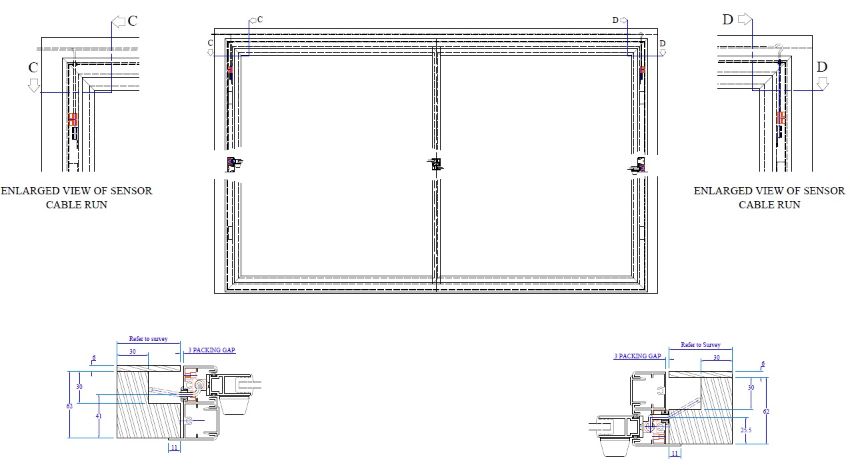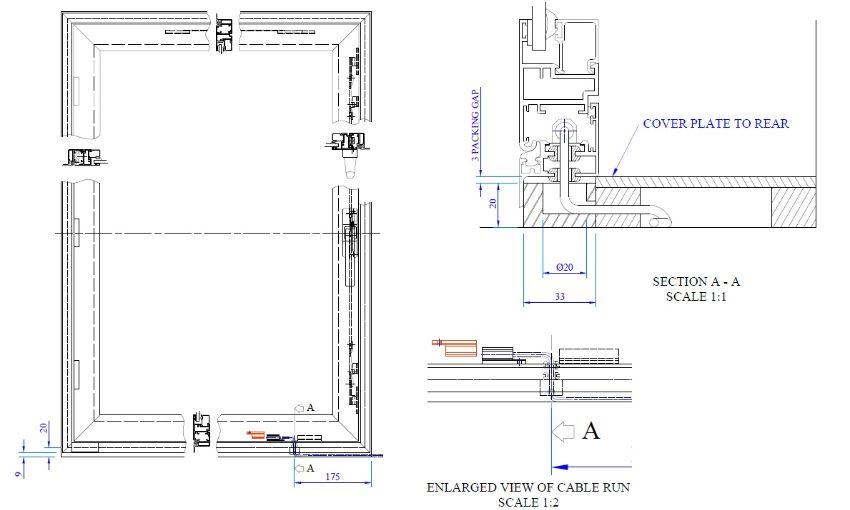On occasion, we have delivered a unique offering to clients to substantiate the security credentials of our heavy-duty secondary glazing units like the Series 80 horizontal slider and Series 90 vertical slider.
In most cases, proximity alarms and trembler sensors are affixed to primary windows as they are normally the first barrier to entry; crucial components in a security system. A magnet and switch are attached to the window frame, and if the window is closed, the magnets keep the switch circuit intact. If the window is opened while the system is armed, the magnet is pulled away and the circuit breaks, which triggers the alarms.
Some primary windows however do not have the capacity to allow for alarms like this. For example, if an alarmed traditional sash window has loose joints, sensors could get unnecessarily triggered on a windy day. Also, there may be some instances where there will not be a large enough cavity to allow for affixing alarm contacts to a primary window. If secondary glazing is specified on a project where alarm systems cannot perform adequately on the primary windows, alarm contacts can be fitted to our units. Careful consideration needs to be given though, as individual project needs are very site-specific.
 Alarm contacts and concealed cabling affixed to Series 80 two-pane horizontal unit
One of our clients, overseeing the development of some high-end residential properties in London, was unable to install alarm contacts because their original bay windows were simply not large enough. The customer insisted that they did not want vibration sensors, but to include alarm contacts in the secondary glazing; so Selectaglaze developed a bespoke solution based on the requirements. The most obvious place would be to put the sensor on the interlock, so whenever the sashes were opened it would break the connection, but the client wanted everything hidden.
Three secondary glazed units were coupled in each opening – a combination of vertical and horizontal sliders. Each of the three units in the opening required two sets of alarm contacts; one for each of the sliding sashes. Therefore, there were six lots of cables to manage. This was achieved effectively through redesigning existing units with the addition of an enlarged head on the timber grounds, with a rebated gap behind it for the cables to be fed through. This was rebated and covered to ensure all wiring was concealed.
Alarm contacts and concealed cabling affixed to Series 80 two-pane horizontal unit
One of our clients, overseeing the development of some high-end residential properties in London, was unable to install alarm contacts because their original bay windows were simply not large enough. The customer insisted that they did not want vibration sensors, but to include alarm contacts in the secondary glazing; so Selectaglaze developed a bespoke solution based on the requirements. The most obvious place would be to put the sensor on the interlock, so whenever the sashes were opened it would break the connection, but the client wanted everything hidden.
Three secondary glazed units were coupled in each opening – a combination of vertical and horizontal sliders. Each of the three units in the opening required two sets of alarm contacts; one for each of the sliding sashes. Therefore, there were six lots of cables to manage. This was achieved effectively through redesigning existing units with the addition of an enlarged head on the timber grounds, with a rebated gap behind it for the cables to be fed through. This was rebated and covered to ensure all wiring was concealed.
 CAD design of internal cable runs in alarmed secondary sliding sashes for residential job
Another recent job; a renowned Listed site in the heart of London, specified alarms on all of the secondary glazing units. However, the requirement in this instance was to ensure that all secondary glazing was closed when the building was secured. This was to cater for any future high-profile visitors. Once again, magnetic alarm sensors were mounted and concealed within our secondary glazing install, with the cabling housed away neatly and discreetly by a cover plate.
CAD design of internal cable runs in alarmed secondary sliding sashes for residential job
Another recent job; a renowned Listed site in the heart of London, specified alarms on all of the secondary glazing units. However, the requirement in this instance was to ensure that all secondary glazing was closed when the building was secured. This was to cater for any future high-profile visitors. Once again, magnetic alarm sensors were mounted and concealed within our secondary glazing install, with the cabling housed away neatly and discreetly by a cover plate.
 CAD Design detailing alarm sensors and cable runs in secondary glazed unit for Listed London site
CAD Design detailing alarm sensors and cable runs in secondary glazed unit for Listed London site
 Alarm contacts and concealed cabling affixed to Series 80 two-pane horizontal unit
One of our clients, overseeing the development of some high-end residential properties in London, was unable to install alarm contacts because their original bay windows were simply not large enough. The customer insisted that they did not want vibration sensors, but to include alarm contacts in the secondary glazing; so Selectaglaze developed a bespoke solution based on the requirements. The most obvious place would be to put the sensor on the interlock, so whenever the sashes were opened it would break the connection, but the client wanted everything hidden.
Three secondary glazed units were coupled in each opening – a combination of vertical and horizontal sliders. Each of the three units in the opening required two sets of alarm contacts; one for each of the sliding sashes. Therefore, there were six lots of cables to manage. This was achieved effectively through redesigning existing units with the addition of an enlarged head on the timber grounds, with a rebated gap behind it for the cables to be fed through. This was rebated and covered to ensure all wiring was concealed.
Alarm contacts and concealed cabling affixed to Series 80 two-pane horizontal unit
One of our clients, overseeing the development of some high-end residential properties in London, was unable to install alarm contacts because their original bay windows were simply not large enough. The customer insisted that they did not want vibration sensors, but to include alarm contacts in the secondary glazing; so Selectaglaze developed a bespoke solution based on the requirements. The most obvious place would be to put the sensor on the interlock, so whenever the sashes were opened it would break the connection, but the client wanted everything hidden.
Three secondary glazed units were coupled in each opening – a combination of vertical and horizontal sliders. Each of the three units in the opening required two sets of alarm contacts; one for each of the sliding sashes. Therefore, there were six lots of cables to manage. This was achieved effectively through redesigning existing units with the addition of an enlarged head on the timber grounds, with a rebated gap behind it for the cables to be fed through. This was rebated and covered to ensure all wiring was concealed.
 CAD design of internal cable runs in alarmed secondary sliding sashes for residential job
Another recent job; a renowned Listed site in the heart of London, specified alarms on all of the secondary glazing units. However, the requirement in this instance was to ensure that all secondary glazing was closed when the building was secured. This was to cater for any future high-profile visitors. Once again, magnetic alarm sensors were mounted and concealed within our secondary glazing install, with the cabling housed away neatly and discreetly by a cover plate.
CAD design of internal cable runs in alarmed secondary sliding sashes for residential job
Another recent job; a renowned Listed site in the heart of London, specified alarms on all of the secondary glazing units. However, the requirement in this instance was to ensure that all secondary glazing was closed when the building was secured. This was to cater for any future high-profile visitors. Once again, magnetic alarm sensors were mounted and concealed within our secondary glazing install, with the cabling housed away neatly and discreetly by a cover plate.
 CAD Design detailing alarm sensors and cable runs in secondary glazed unit for Listed London site
CAD Design detailing alarm sensors and cable runs in secondary glazed unit for Listed London site- Date
- Category
- Secondary Glazing in Practice